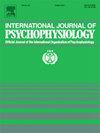避免-避免冲突任务中的脑电图θ和α生物标记物:与焦虑的联系
IF 2.6
3区 心理学
Q3 NEUROSCIENCES
引用次数: 0
摘要
目标冲突是焦虑处理的核心,但某些形式的目标冲突,如回避-回避,在脑电图研究中仍未得到充分研究。本研究将操纵杆操作跑道任务(JORT)与脑电图结合使用,探索与行为抑制系统(BIS)相关的目标冲突的神经生物标志物,这是强化敏感性理论(RST)的一个关键组成部分。采用一种新颖的试验校准系统(TCS)来控制高冲突和低冲突条件下被试的运动活动和任务难度。40名右撇子参与者(18-24岁)完成了适应脑电图的JORT,其中通过改变厌恶刺激的速度来操纵冲突。行为数据证实了有效的目标冲突诱导:高冲突试验产生较慢的反应时间,更多的操纵杆运动,以及接近52%的表现准确性,表明平衡冲突。使用电流源密度(CSD)变换的脑电图分析显示,在高冲突试验中,右额波功率和相干性增加,与BIS参与一致。在低冲突状态下,左额叶α能量和连贯性更为突出,而高冲突状态下,顶枕叶α能量也会升高,提示在早期威胁检测和感觉整合中起作用。这些结果表明,避免-避免目标冲突可靠地激活了bis相关的神经系统,并且更新的JORT为研究焦虑相关的生物标志物提供了有效的方法。使用电机校准框架,这是第一个将脑电图与避免-避免冲突范式相结合的研究。未来的工作应该检查药理学调节和包括临床样本,以进一步验证观察到的焦虑相关冲突处理的神经模式的特异性。本文章由计算机程序翻译,如有差异,请以英文原文为准。
EEG theta and alpha biomarkers during an avoid-avoid conflict task: Links to anxiety
Goal conflict is central to anxiety processing, but certain forms of goal conflict, such as avoid-avoid, remain under-investigated in EEG research. This study adapted the Joystick Operated Runway Task (JORT) for use with EEG to explore neural biomarkers of goal conflict related to the Behavioural Inhibition System (BIS), a key component of Reinforcement Sensitivity Theory (RST). A novel Trial Calibration System (TCS) was implemented to control motor activity and equate task difficulty across participants during high and low conflict conditions. Forty right-handed participants (aged 18–24) completed the EEG-adapted JORT, where conflict was manipulated by varying the speed of aversive stimuli. Behavioural data confirmed effective goal conflict induction: high conflict trials produced slower reaction times, more joystick movements, and a performance accuracy near 52 %, indicating a balanced conflict. EEG analyses using Current Source Density (CSD) transformations revealed increased right-frontal theta power and coherence during high conflict trials, consistent with BIS engagement. Left-frontal alpha power and coherence were more prominent during low conflict, while high conflict also produced elevated alpha power in parieto-occipital regions, suggesting roles in early threat detection and sensory integration. These results suggest that avoid-avoid goal conflict reliably activates BIS-related neural systems and that the updated JORT provides a valid method for studying anxiety-related biomarkers. Using a motor-calibrated framework, this is the first study to integrate EEG with an avoid-avoid conflict paradigm. Future work should examine pharmacological modulation and include clinical samples to further validate the specificity of the observed neural patterns for anxiety-related conflict processing.
求助全文
通过发布文献求助,成功后即可免费获取论文全文。
去求助
来源期刊
CiteScore
5.40
自引率
10.00%
发文量
177
审稿时长
3-8 weeks
期刊介绍:
The International Journal of Psychophysiology is the official journal of the International Organization of Psychophysiology, and provides a respected forum for the publication of high quality original contributions on all aspects of psychophysiology. The journal is interdisciplinary and aims to integrate the neurosciences and behavioral sciences. Empirical, theoretical, and review articles are encouraged in the following areas:
• Cerebral psychophysiology: including functional brain mapping and neuroimaging with Event-Related Potentials (ERPs), Positron Emission Tomography (PET), Functional Magnetic Resonance Imaging (fMRI) and Electroencephalographic studies.
• Autonomic functions: including bilateral electrodermal activity, pupillometry and blood volume changes.
• Cardiovascular Psychophysiology:including studies of blood pressure, cardiac functioning and respiration.
• Somatic psychophysiology: including muscle activity, eye movements and eye blinks.

 求助内容:
求助内容: 应助结果提醒方式:
应助结果提醒方式:


